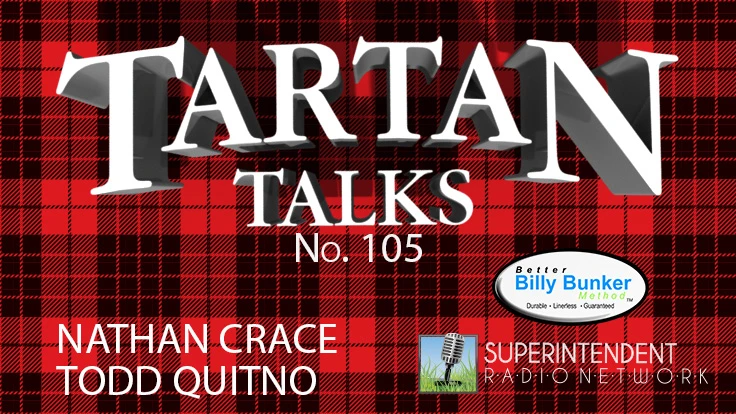Is seashore paspalum the next big thing? If so, how the heck do you manage the stuff?
That was the topic addressed by golf course superintendents, university researchers and turfgrass growers who gathered at the Ritz-Carlton Golf Resort in Naples, Fla., in July at an event sponsored by Bayer Environmental Science.
Speakers discussed the advantages and disadvantages of paspalum, as well as various cultural practices needed to manage the grass. But use of the turf is still in its infancy, and Todd Lowe, a Green Section agronomist with the U.S. Golf Association, offered one important caveat.
“What we see in research may or may not correlate to what we see in the field,” he says.
One potentially big advantage of paspalum is the money saved in water use because it can use anywhere from 10 to 20 percent less water than Bermudagrass. But, overall, the cost to maintain paspalum is about same as Bermudagrass, according to some superintendents who have managed both. Another advantage of paspalum, according to superintendents, is that it can be taken to tournament level 80 percent of the time.
From a practical standpoint, one reason to convert from Bermudagrass to seashore paspalum is if you have poor water quality, says Scott Hamm, CGCS, at The Colony Golf and Bay Club. Hamm made the conversion and offers tips for grassing-in paspalum:
• Install mist heads around bunkers.
• Keep the sprigs wet. If they get dry, they die.
• Apply a preemergence herbicide.
• Aerify.
• Topdress. It acts like a fertilizer.
• Protect drains from sediment.
• Once established, dry it out. Push it to get deep roots.
• Take soil samples before you fumigate, and base fertilization on soil samples.
• Use one pound of nitrogen every 14 days until the turf is 90 percent grown in.
• Mow as soon as possible. Test the grass. If you can pull on the grass and it doesn’t come out, it’s ready to be mowed.
• Roll greens as much as possible.
• Spray microbes to reduce thatch.
Aside from establishing paspalum, there’s much to be learned about pesticide use on the turf. Tim Murphy, a professor in the department of crop and soil sciences at the University of Georgia, provides some insight. He has conducted herbicide research and has found:
• Paspalum is tolerant of Dimension, Ronstar G and Barricade.
• Improvement of postemergence herbicides is needed. There’s low or unacceptable tolerance of Monument and Revolver.
• Paspalum has good tolerance of SedgeHammer, Image, flazasulfuron, Revolver (less than two fluid ounces) Certainty, Manor, Blade, Trimec, QuickSilver, Dismiss and SpeedZone, Kerb, Drive, Sencor and Basagram.
• There’s no postcontrol of goosegrass, sandbur, fall panicum, dalligrass, vaseygrass and other warm-season turfgrasses.
• There’s no problem controlling annual or perennial broadleaf weeds, sedges and kyllinga.
• Progress and Cutlass used with saltwater can slow or kill Bermudagrass, keeping it out of paspalum if there’s both on a course.
• QuickSilver can be used on newly sprigged and seeded grass.
• Paspalum is tolerant to Primo Maxx and Trimmit.
• Higher rates of Primo can give 20- to 27-percent injury; a 0.25 to 0.38 rate of Primo results in injury of less than 14 percent; and at a 0.75 rate of primo there’s and 80-percent shutdown of the plant.
• But a monthly application of Primo Maxx and Trimmit provides good seedhead suppression.
“If you are extremely color conscious, you can’t use some herbicides because they cause yellowing of seashore paspalum, but the paspalum recovers well,” Murphy says.
There’s also work being done to find out more about diseases that affect paspalum. Bruce Martin, Ph.D., from Clemson University says large patch and dollar spot are the two biggies. Others include pythium blight, root rot, fairy ring, nematodes, take-all root rot, leaf spot and fusarium patch.
Large patch doesn’t attack rhizomes, so it doesn’t last more than about two weeks, Martin says. It goes away when soil temperatures increase. Large patch is most destructive during the spring and fall and winter under cool, wet weather. As the grass goes into dormancy, large patch isn’t visible.
Azoxystrobin and flutolanil are two most common active ingredients used to treat large patch, and to get preventive control, apply these in the fall. Curative applications don’t work, Martin says.
“Superintendents need to make sure they manage drainage because large patch is seen in low areas that have drainage problems,” he says. “You want to spray with a gallon-per-thousand because you need to get the fungicide down in the plant.”
Martin says he’s never seen resistance in warm-season grasses with fungicides treating dollar spot.
Overall, the quality of paspalum greens are just as good as TifEagle greens, according to some superintendents who have managed both types. But they say you might have to work harder to achieve desired results.
All things considered, superintendents say one needs a different mentality when managing paspalum because it requires less water and nitrogen. GCN
Traits of seashore paspalum
Positives:
• Less nitrogen is needed
• Wide soil pH range
• Less need for edging
• Not affected by cloudy, rainy weather
• Tight canopy
• Is said to handle nematodes better than Bermudagrass
• Tolerates low mowing height
• Forms stolons and rhizomes
• Has a deep green color
• Is very aggressive
• No “grain”
• Genetically stable
• Can be overseeded
• Tolerates brackish water
• High root volume
• Striped when mowed
• Responds to PGRs
• Waxy leaf; minimal morning dew
• Good color retention during the winter
• Tolerates water-logging
• Can recover from grubs quicker because of strong root system.
Negatives:
• Few pesticides are labeled for it
• It’s slow to recover from scalping
• Minimal tree shade tolerance
• Difficult to establish with saline water
• Produces seed heads
• Slower green speeds
• Disease can be an issue
• Green-up can be slow in the spring
• Dormant color is dirty brown
• Cold hardiness is similar to hybrid Bermudagrass
• Fewer herbicides are labeled for it than Bermudagrass
• Low roughs
• Thatch buildup
• More regular disease
Seashore paspalum cultural practices
• The height of cut on greens is between 0.09 to 0.13 of an inch.
• Use three to six pounds of nitrogen per 1,000 square feet per year.
• Rolling is needed on greens.
• Use three to five ounces of Primo Maxx a week on greens. You can use more if needed.
• Use six to eight ounces of Primo Maxx per acre in fairways and rough.
• The recommended height of cut is 0.30 to 0.50 of an inch on tees and fairways.
• Because of thatch, verticut yearly.
• A salinity management program needs to include a periodic flushing with freshwater to drain the soils.
• Aerify three to five times a year.
• Using Proxy and Trimmit reduce seedheads.
• Topdress frequently (once a week) and lightly on greens. Topdress once a quarter on fairways
• Use very sharp bed knives.
Get curated news on YOUR industry.
Enter your email to receive our newsletters.
Explore the September 2006 Issue
Check out more from this issue and find your next story to read.
Latest from Golf Course Industry
- Beyond the Page 65: New faces on the back page
- From the publisher’s pen: New? No way!
- Indiana course upgrades range with synthetic ‘bunkers’
- Monterey Peninsula CC Shore Course renovation almost finished
- KemperSports and Touchstone Golf announce partnership
- PBI-Gordon Company hires marketing manager Jared Hoyle
- Mountain Sky Guest Ranch announces bunker enhancement project
- GCSAA names Joshua Tapp director of environmental programs





